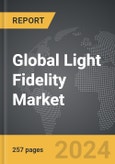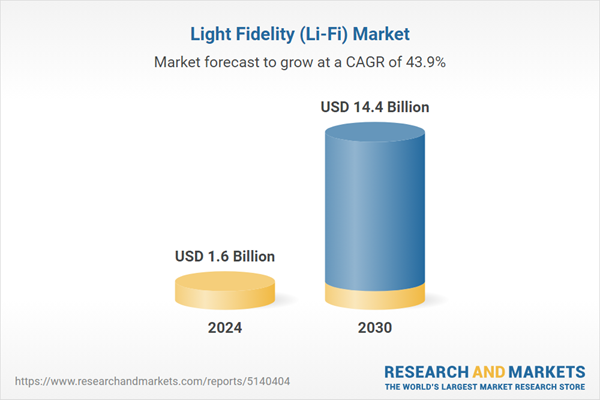The global market for Light Fidelity (Li-Fi) was valued at US$1.6 Billion in 2024 and is projected to reach US$14.4 Billion by 2030, growing at a CAGR of 43.9% from 2024 to 2030. This comprehensive report provides an in-depth analysis of market trends, drivers, and forecasts, helping you make informed business decisions. The report includes the most recent global tariff developments and how they impact the Light Fidelity (Li-Fi) market.
Segments: Component (LEDs, Photo Detectors, Microcontrollers, Other Components); Application (Indoor Networking Application, Location-Based Services (LBS) Application, In-Flight Communications & Entertainment (IFCE) Application, Underwater Communications Application, Other Applications); End-Use (Healthcare End-Use, Retail End-Use, Education End-Use, Aerospace & Defense End-Use, Automotive End-Use, Government End-Use, Other End-Uses).
Geographic Regions/Countries: World; USA; Canada; Japan; China; Europe; France; Germany; Italy; UK; Rest of Europe; Asia-Pacific; Rest of World.
The analysts continuously track trade developments worldwide, drawing insights from leading global economists and over 200 industry and policy institutions, including think tanks, trade organizations, and national economic advisory bodies. This intelligence is integrated into forecasting models to provide timely, data-driven analysis of emerging risks and opportunities.
Global Light Fidelity (Li-Fi) Market - Key Trends and Drivers Summarized
How Does Li-Fi Technology Work and What Are Its Essential Components?
Light Fidelity (Li-Fi) is an emerging communication technology that transmits data using visible light rather than traditional radio waves, offering a promising alternative to Wi-Fi. Li-Fi systems primarily operate through three major components: Light-Emitting Diodes (LEDs), photo detectors, and microcontrollers. LEDs act as the primary source of light modulation, emitting light signals that carry data. These LEDs are engineered to switch on and off at extremely high speeds, enabling rapid data transfer that remains invisible to the human eye. Photo detectors, another key component, receive the light signals and convert them into electrical signals for data decoding. Microcontrollers manage the data flow, acting as the core processing unit that facilitates signal modulation and demodulation. Other critical components of Li-Fi include optical amplifiers, signal processing chips, and sensors that enhance signal strength, speed, and quality. Collectively, these elements enable Li-Fi systems to achieve high-speed, secure, and efficient data communication.What Applications Showcase the Versatility of Li-Fi?
Li-Fi technology is demonstrating significant potential across various applications, reshaping the way data is transmitted in different environments. One prominent application is indoor networking, where Li-Fi offers a secure, interference-free solution for high-speed data exchange within enclosed spaces such as offices, malls, and homes. It is also effective in location-based services (LBS), enabling precise indoor positioning and navigation, particularly useful in retail and healthcare settings. In-flight communications and entertainment (IFCE) is another significant application, where Li-Fi helps to provide reliable, interference-free connectivity inside aircraft, enhancing passenger experience without compromising safety. Moreover, the unique properties of Li-Fi make it a suitable option for underwater communications, where radio waves are ineffective due to high attenuation rates. This application is particularly valuable for underwater exploration, military operations, and scientific research. Other noteworthy applications include vehicle-to-vehicle (V2V) communication in the automotive sector, secure communication channels in defense, and connectivity in crowded urban areas, where radio spectrum congestion is a challenge.Which Sectors Are the Biggest Beneficiaries of Li-Fi Technology?
Li-Fi’s potential is being tapped across multiple sectors, with diverse end-use cases driving its adoption. In healthcare, Li-Fi offers a reliable communication solution that minimizes electromagnetic interference, making it suitable for medical environments such as hospitals and clinics. It enhances patient monitoring systems and facilitates high-speed data sharing for electronic health records (EHRs). The retail sector utilizes Li-Fi for advanced analytics and targeted advertising through LBS, improving customer engagement and sales strategies. In education, Li-Fi provides fast and secure connectivity in smart classrooms, supporting interactive learning and real-time data sharing. Aerospace and defense industries benefit from the technology's secure and interference-resistant nature, using it for mission-critical communications and secure data transfer. The automotive industry explores Li-Fi for V2V and vehicle-to-infrastructure (V2I) communication, boosting autonomous vehicle systems and traffic management. Government entities are considering Li-Fi for secure communication infrastructure and smart city initiatives, including intelligent lighting systems and public safety networks. Other notable sectors include manufacturing, where Li-Fi supports the Industrial Internet of Things (IIoT), and hospitality, where it offers seamless connectivity for guests.What Factors Are Driving the Growth in the Li-Fi Market?
The growth in the Li-Fi market is driven by several factors that stem from technological innovations, expanding applications, and increasing adoption across various industries. A significant driver is the growing demand for high-speed and secure communication, particularly in environments where radio frequency (RF) technologies face limitations, such as healthcare, aviation, and underwater communications. Li-Fi's capability to offer faster data rates, reduced latency, and higher security compared to traditional Wi-Fi is boosting its adoption in critical sectors like defense, aerospace, and financial services, where data confidentiality and rapid transmission are paramount. Moreover, the increasing prevalence of smart devices and the Internet of Things (IoT) is pushing the need for seamless connectivity, with Li-Fi emerging as a complementary solution to manage the congested RF spectrum. The rising demand for advanced positioning systems in retail and public infrastructure also propels the adoption of Li-Fi-enabled LBS. Regulatory initiatives supporting smart city developments further drive the need for Li-Fi-based intelligent lighting systems. In addition, government efforts to improve connectivity and digital infrastructure, particularly in emerging economies, are creating growth opportunities for Li-Fi market expansion.Report Scope
The report analyzes the Light Fidelity (Li-Fi) market, presented in terms of units. The analysis covers the key segments and geographic regions outlined below.Segments: Component (LEDs, Photo Detectors, Microcontrollers, Other Components); Application (Indoor Networking Application, Location-Based Services (LBS) Application, In-Flight Communications & Entertainment (IFCE) Application, Underwater Communications Application, Other Applications); End-Use (Healthcare End-Use, Retail End-Use, Education End-Use, Aerospace & Defense End-Use, Automotive End-Use, Government End-Use, Other End-Uses).
Geographic Regions/Countries: World; USA; Canada; Japan; China; Europe; France; Germany; Italy; UK; Rest of Europe; Asia-Pacific; Rest of World.
Key Insights:
- Market Growth: Understand the significant growth trajectory of the Indoor Networking Application segment, which is expected to reach US$6.7 Billion by 2030 with a CAGR of a 46.2%. The Location-Based Services (LBS) Application segment is also set to grow at 44.7% CAGR over the analysis period.
- Regional Analysis: Gain insights into the U.S. market, valued at $521.3 Million in 2024, and China, forecasted to grow at an impressive 49.1% CAGR to reach $1.4 Billion by 2030. Discover growth trends in other key regions, including Japan, Canada, Germany, and the Asia-Pacific.
Why You Should Buy This Report:
- Detailed Market Analysis: Access a thorough analysis of the Global Light Fidelity (Li-Fi) Market, covering all major geographic regions and market segments.
- Competitive Insights: Get an overview of the competitive landscape, including the market presence of major players across different geographies.
- Future Trends and Drivers: Understand the key trends and drivers shaping the future of the Global Light Fidelity (Li-Fi) Market.
- Actionable Insights: Benefit from actionable insights that can help you identify new revenue opportunities and make strategic business decisions.
Key Questions Answered:
- How is the Global Light Fidelity (Li-Fi) Market expected to evolve by 2030?
- What are the main drivers and restraints affecting the market?
- Which market segments will grow the most over the forecast period?
- How will market shares for different regions and segments change by 2030?
- Who are the leading players in the market, and what are their prospects?
Report Features:
- Comprehensive Market Data: Independent analysis of annual sales and market forecasts in US$ Million from 2024 to 2030.
- In-Depth Regional Analysis: Detailed insights into key markets, including the U.S., China, Japan, Canada, Europe, Asia-Pacific, Latin America, Middle East, and Africa.
- Company Profiles: Coverage of players such as IDRO Co. Ltd., KYOCERA SLD Laser, Inc., LightBee Corp, Lvx System, Oledcomm SAS and more.
- Complimentary Updates: Receive free report updates for one year to keep you informed of the latest market developments.
Some of the 34 companies featured in this Light Fidelity (Li-Fi) market report include:
- IDRO Co. Ltd.
- KYOCERA SLD Laser, Inc.
- LightBee Corp
- Lvx System
- Oledcomm SAS
- PureLiFi Ltd.
- Signify Holding BV
- Velmenni
- Wipro Lighting
- Zero1 Pte Ltd
Tariff Impact Analysis: Key Insights for 2025
Global tariff negotiations across 180+ countries are reshaping supply chains, costs, and competitiveness. This report reflects the latest developments as of April 2025 and incorporates forward-looking insights into the market outlook.The analysts continuously track trade developments worldwide, drawing insights from leading global economists and over 200 industry and policy institutions, including think tanks, trade organizations, and national economic advisory bodies. This intelligence is integrated into forecasting models to provide timely, data-driven analysis of emerging risks and opportunities.
What’s Included in This Edition:
- Tariff-adjusted market forecasts by region and segment
- Analysis of cost and supply chain implications by sourcing and trade exposure
- Strategic insights into geographic shifts
Buyers receive a free July 2025 update with:
- Finalized tariff impacts and new trade agreement effects
- Updated projections reflecting global sourcing and cost shifts
- Expanded country-specific coverage across the industry
Table of Contents
I. METHODOLOGYII. EXECUTIVE SUMMARY2. FOCUS ON SELECT PLAYERSIII. MARKET ANALYSISCANADAJAPANCHINAFRANCEGERMANYITALYUNITED KINGDOMREST OF EUROPEREST OF WORLDIV. COMPETITION
1. MARKET OVERVIEW
3. MARKET TRENDS & DRIVERS
4. GLOBAL MARKET PERSPECTIVE
UNITED STATES
EUROPE
ASIA-PACIFIC
Companies Mentioned (Partial List)
A selection of companies mentioned in this report includes, but is not limited to:
- IDRO Co. Ltd.
- KYOCERA SLD Laser, Inc.
- LightBee Corp
- Lvx System
- Oledcomm SAS
- PureLiFi Ltd.
- Signify Holding BV
- Velmenni
- Wipro Lighting
- Zero1 Pte Ltd
Table Information
| Report Attribute | Details |
|---|---|
| No. of Pages | 271 |
| Published | April 2025 |
| Forecast Period | 2024 - 2030 |
| Estimated Market Value ( USD | $ 1.6 Billion |
| Forecasted Market Value ( USD | $ 14.4 Billion |
| Compound Annual Growth Rate | 43.9% |
| Regions Covered | Global |









